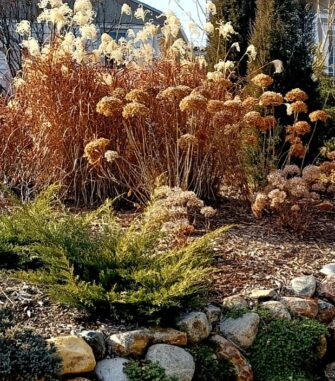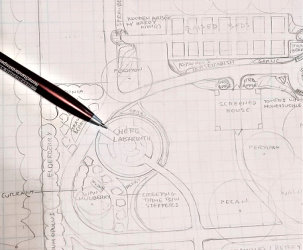
Although deciduous shrubs and perennials go dormant and lose their leaves during the cold Nebraska winter months, they can still provide great visual interest. The subtle beauty of the landscape is easiest to appreciate when everything around it has died back–dried blooms, interesting seed heads, grasses, colored bark and twisted branches can come together to create a fabulous, textural display through the winter months.
-Dogwoods are well-known for their yellow or red branches that provide a pop of color in the winter landscape. Once all the leaves drop off in fall, the colored branches really stand out against the white snow, or paired with an evergreen–especially one with silver/blue foliage.. -Harry Lauder’s Walking Stick (Corylus avellana ‘Contorta’) has wonderfully twisted and contorted branches that are most visible when the plant is dormant.
-Many hydrangea blooms will hold their shape beautifully on the shrub after they dry up. The big blooms are fabulous on their own, but a fresh dusting of snow makes a picturesque scene. -There are also many types of crabapple trees with berries that persist throughout the winter. These berries can add color to the tree, as well as attract wildlife to your yard.
By definition, herbaceous perennials have leaves and stalks that die back when the temperature drops. So it makes sense that perennials are widely ignored in the winter. However, certain plants can keep their form.
-Sedum blooms will persist all winter, and like hydrangeas, they look especially pretty in the snow.
-Grasses are commonly left standing until the spring. The tan, dried foliage provides a nice texture, and grasses like Miscanthus and switchgrass are especially lovely, as they have decorative seed heads that almost glow gold in the afternoon sun.
-The seedheads of coneflowers, penstemon and others provide a nice textural interest along with food for birds like the goldfinch. (A note of warning about leaving the seedheads on these perennials–while they look great and the birds are thankful, the plants are likely to self seed and pop up in unplanned areas around the landscape if seedheads are not removed. This is a boon to some people, and a detriment to others, so just proceed accordingly 🙂
There are even some “evergreen” perennials. Lenten Rose (Helleborus), ajuga, coral bells, and several others keep their leaves through winter. Lenten rose leaves stay dark green, while ajuga can turn a purple hue.
This is just the tip of the iceberg. There are many deciduous plants that can provide winter interest in the landscape. Experiment with cutting some back perennials in the spring, rather than in the fall ; you may be surprised what looks good in the winter landscape!








